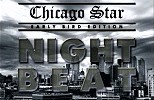
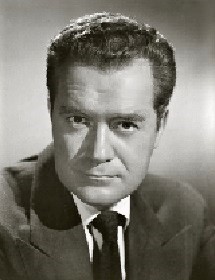 Nightbeat (1950-52) aired “The Slasher” on November 10, 1950 as the 40th episode of an estimated 104. Some 74-78 episodes remain in circulation. This radio noir “detective” show featured film–and later TV–star Frank Lovejoy (1912-1962) as Randy Stone, the nightbeat reporter for the fictional Chicago Star newspaper.
Nightbeat (1950-52) aired “The Slasher” on November 10, 1950 as the 40th episode of an estimated 104. Some 74-78 episodes remain in circulation. This radio noir “detective” show featured film–and later TV–star Frank Lovejoy (1912-1962) as Randy Stone, the nightbeat reporter for the fictional Chicago Star newspaper.
This is only the third episode of Night Beat we have presented, the first being “The Devil’s Bible” from July of 2013, and the second “Mentallo, the Mental Marvel” from May of this year. So a bit of background on the show is in order for newcomers to the show. While well received, it ran for a modest two years before being cancelled, but not from any fault of its own. It had two factors going against it, both with origins at NBC. The time for a new radio show, and for a network to pour money into it, wasn’t the best. The early 1950s was becoming a growth spurt for the relatively new medium of television, and advertisers realizing its much larger potential audience were diverting their ad dollars away from radio and into this promising new market. Secondly, and for whatever reason, NBC around this time had a reputation for not supporting many of its shows with in-house advertising around the country, or allowing them the benefit of stable time slots so audiences could plan on listening to their favorite shows at a regular time. Both of these factors had a role in Night Beat‘s short life span. NBC would move it from one day of the week to another and at a different nightly time slot, without notice or fanfare, making it difficult for its audience to follow. Thus, while the show was a success, it was in spite of NBC, not because of anything its parent network did to support it.
As noted above, Frank Lovejoy portrayed Randy Stone, the night beat reporter for the fictional newspaper, the Chicago Star. He wasn’t the show’s first coice, however. Noted film actor Edmond O’Brien played Stone in an audition episode, but the censorship watchdogs that had for a long time been active in radio felt O’Brien’s hardcore, gritty characterization of Stone to be too stark for younger listeners, so decreed that Night Beat would have to air in a later time slot if it was to be given a green light. Rather than moving their new show in the making to a late night venue (with fewer listeners and thus fewer potential ad dollars spent), they would soften the Stone character. Enter Frank Lovejoy, with a voice historians would later place in the top ten of the most distinctive voices in radio. Lovejoy also brought his own sense of down to earth humanity and heartfelt compassion to the role (which he did to all of his radio roles, some 3,000 productions during his radio career), and Night Beat had its winning formula.
Lovejoy was a well known and respected film actor in the 1940s and 50s, having supporting or major roles in more than two dozen films, a scant few of many worth mentioning being 1949’s In a Lonely Place (starring Humphrey Bogart), and the title role in the classic 1951 noir crime thriller I Was a Communist for the FBI. Lovejoy featured prominently in several world War II and/or Korean War films, the most high profile probably his co-starring role with James Stewart in 1954’s Strategic Air Command. Of interest to genre fans is Lovejoy’s role as Lt. Tom Brennan opposite Vincent Price in the 1953 3D horror flick House of Wax (the first color 3D film to be released by a major American studio, and the first in a regular theater setting to offer stereophonic sound).
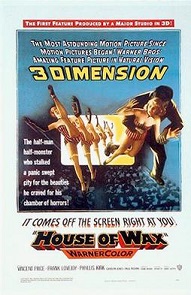
“The Slasher,” on its surface and by its title, would appear to be a straightforward tale of a madman with a knife. Don’t be deceived into thinking that this element takes up center stage, however, for the focus of this tale concerns the sometimes thinly-veiled and deceptive borderland between love and hate. I wonder how the theme of this particular story would be interpreted in light of today’s social climate.
Play Time: 29:31
{Bored to death with school and homework, and in between holidays in early November of 1950, the neighborhood gang decided to break the monotony of sitting in classrooms by sneaking in their recent purchases from the corner newsstand. Unfortunately, eagle-eyed teachers busted our stalwart pulp magazine fans reading in class and confiscated their magazines. Jungle Stories (1938-54) promised action and adventure stories that usually held to the formula represented on many of its covers: a scantily clad female in the process of being saved by Ki-Gor, Lord of the Jungle (and obviously a carbon copy of the more popular forerunner, Tarzan) from a variety of imminent dangers. It was a quarterly in 1950. The Phantom Detective (1933-53) was a favorite with its masked detective standing up for the Right and the Good against the Bad and the Evil–especially when there was a damsel in distress. It, too, was a quarterly in 1950. Thrilling Detective (1931-53) was one of the relatively small number of crime and/or detective magazines still publishing into the 1950s from the glut flooding the newsstands in the 1930s. It was a bi-monthly in 1950.}
[Left: Jungle Stories Fall 1950 – Center: Phantom Detective, Fall 1950 – Right: Thrilling Detective, Oct. 1950]
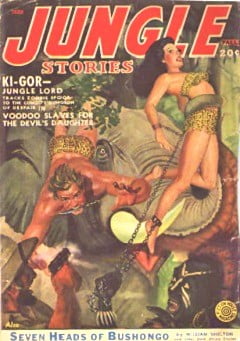
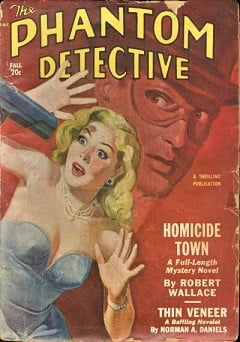
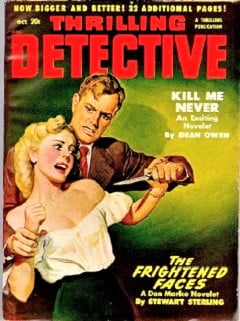
To view the entire list of weekly Old Time Radio episodes at Tangent Online, click here.